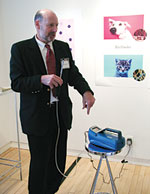
They also had the opportunity to learn about how many portable room cleaners it takes to do the job of one particular whole-house air cleaner. This should be welcome data for air conditioning and heating contractors, who face consumers that have been spending more than $500 million a year on plug-in room air cleaners, estimated the manufacturer.
"We want to clear the air, quite literally," said Dave Pannier, president, Residential Systems, for American Standard Companies, responsible for both the Trane and American Standard brands of indoor comfort products. EPA ranks indoor air quality (IAQ) in the top five health risks.
The multimillion dollar loft was temporarily transformed into a Trane indoor discovery center.
Environmental Health and Engineering (EH&E), Newton, Mass., evaluated the performance of Trane's CleanEffects whole-house air-cleaning system through comparison to industry standards, the performance of alternative systems, and health-based considerations.

STARK COMPARISON
The testing was conducted as a joint research project between investigators from EH&E and from the Harvard School of Public Health. The evaluation was conducted between May and December 2005 in a 1,350-square-foot, multiroom modular test home located adjacent to EH&E's main office in Newton."The performance of Trane CleanEffects and selected other systems was evaluated in the test home under controlled and well-documented conditions," states the report, "Phase II Efficacy Demonstration of Trane's Whole-House Air-Cleaning System." The in-duct and portable air cleaning systems tested were:
EH&E measured continuous particle concentrations in multiple locations of the test home, in order to determine the whole-house air effectiveness of each air cleaner, after fine dust and fungal spores were introduced (the dust was aerosolized inside the home; the fungal spores were present in outdoor air brought into the home). Based on the data these researchers collected, the efficacy of each filtration method was characterized as the whole-house aerosol removal rate, whole-house clean air delivery rate (WHCADR), and indoor-outdoor ratio.
Ventilation in the test home was provided by a central forced-air air-handling unit (AHU) that provided 1,273 cfm of air. "The supply-air system was balanced so each room received approximately 1 cfm of conditioned air per square foot of floor space," the report states. The AHU did not have an outdoor air intake. Not many residential systems do.
According to the report, "The average whole-house aerosol removal rate for Trane CleanEffects was approximately 7.2 per hour for 0.3- to 0.5-micrometer (µm) particles. In other words, it removed 12 percent of those particles in the indoor air of the test home each minute.
"In comparison, a typical 1-inch disposable filter removed 0.3- to 0.5-µm particles at a rate of 0.03 percent of the particles each minute. The removal of those-size particles by Trane CleanEffects was approximately 360 times faster than removal by the typical 1-inch disposable filter." This is not a tremendous surprise, because these disposable filters are only intended to protect the furnace, not the home's occupants.
The Trane product also performed much better than the portable air cleaners included in the testing. "For 0.3- to 0.5-µm particles, the WHCADR for Trane CleanEffects was nearly two times larger than the WHCADR achieved by five portable air cleaners operated simultaneously. ... These results suggest that 10 of the portable HEPA air cleaners may achieve the same air-cleaning performance of one Trane CleanEffects."

WIDESPREAD IAQ PROBLEMS
John D. Spengler, Ph.D., a professor of environmental health and human habitation at Harvard School of Public Health, discussed the broad ramifications of poor IAQ. "Our measurements [in the test house] had as much exposure to smoke, mold, etc., as kids in Steubenville, Ohio," where the air is constantly monitored for amounts of respirable particulates, such as those generated through the coal industry.Spengler said that in New York City researchers have seen high levels of iron and nickel in children who had to take the subways to school. Pesticides and cockroach particles can also cause breathing problems.
According to data from the U.S. EPA, indoor air is generally four to five times more polluted than outdoor air, with no differences associated for socio-economic status. It's a universal problem.
"People are waking up to the reality of the sad state of their indoor air," said Spengler. "But at the same time, they are finding a dearth of viable indoor air cleaning solutions. The introduction of products like Trane CleanEffects will fundamentally alter the quality of air because they remove airborne respirable particles far more efficiently than other currently available air-cleaning devices."

TRULY PACKAGED SOLUTION
According to the manufacturer, its new air cleaning system costs around $1,400 installed, as part of a new HVAC system or retrofitted to an existing one. The air cleaner itself consists of a prefilter, corona charge section, and a final filter.
Like other EACs, Trane CleanEffects electrically charges airborne particles. These particles are pulled toward collection cells, where they are removed from the air. The Trane product includes a patented technology that is said to intensify the power of the charge, "so that more and smaller particles can be charged and subsequently removed," the company said. The new air cleaner also is said to use less energy than comparable products, and it offers a simple cleaning process - vacuuming or rinsing every three to nine months.

"Indoor air quality is, first and foremost, a health issue," said Steve Arnholt, Trane Residential Systems, indoor air quality systems leader, Tyler, Texas. "By removing up to 99.98 percent of airborne particles from the filtered air, we are making the home a better place for asthma and allergy sufferers and homeowners who simply don't want to inhale things like bacteria, pollen, and pet dander."
For more information, visit www.trane.com.
Publication date: 03/20/2006



